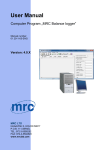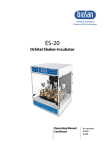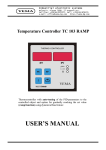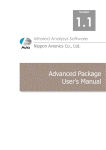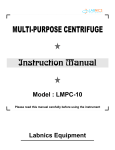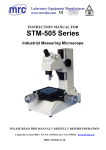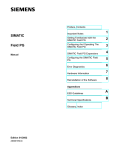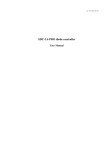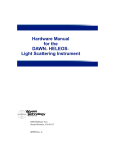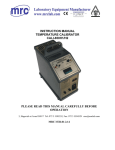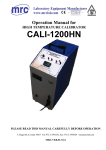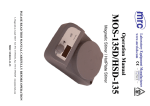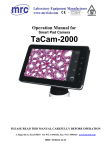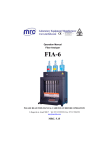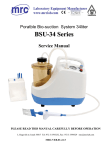Download Operation Manual
Transcript
LOW TEMPERATURE LABORATORY ELECTRIC FURNACE FD 420/300 Operation Manual The product conforms to the requirements of the European Union Low Voltage Directive 2006/95/EC, Electromagnetic Compatibility Directive 2004/108/EC, and Machinery Safety Directive 2006/42/EC. PLEASE READ THIS MANUAL CAREFULLY BEFORE OPERATION 3, Hagavish st. Israel 58817 Tel: 972 3 5595252, Fax: 972 3 5594529 [email protected] MRC.VER.01-8.12 1. PURPOSE Low temperature laboratory electric furnace FD 420/300 is designed for heating or drying materials and stocks in the ambient air temperatures from T+100C to 3000C in static conditions. 2. EXPLANATION OF SYMBOLS AND MARKINGS Explanation of markings alternating current grounding contact danger of electrical shock control of the fan valve Position of the label of the product and explanation Identification on the label Model : FD 60/300 IP 20 No 0000000 220V ~50 Hz 2,0 kW 50kg 10 2008 Meaning Type of furnace, 60 – total chamber volume (60 dm3); 300 – nominal temperature (300ºC). Degrees of protection provided by enclosures EN60529 Number of the product Voltage of power supply 220 V Frequency of electrical current, Hz Nominal power, kW Weight of the product, kg Date of manufacture (month, year) Mark of compatibility to CE Explanation of symbols This symbol indicates important safety requirements disregard of which may cause risk to personal safety and /or to property. Before switching on the low temperature furnace, it is very important to read and follow all the instructions of this manual. This symbol indicates the articles of the manual requirements which must be followed with great care in order to ensure the correct sequence of operations and prevent damage to the furnace and danger to operators. Attention This symbol indicates important information. 3. COMPLEMENT The user is supplied with: Name Quantity Electrical furnace Shelves Passport User manual of temperature controller Fuse FD 420/300 pcs. pcs. pcs. psc. 1 3 1 1 pcs. 2 4. SAFETY REGULATIONS Use the electric furnace according to the requirements of „Users’ technical safety operation rules of electric equipment“. The operator working with the electric furnace must be aware of the operation rules of electric equipment up to 1000V, is acquainted with safety regulations for operation of electric furnace, and is aware of the structure, operation principle, assembly and operation rules of the product. Connect the electric furnace to the mains (power supply) that must have the grounding contact connected to the grounding circuit. It is prohibited to operate the electric furnace if the grounding is insecure. It is prohibited to operate the electric furnace if any of external protective shields is removed. If the electric furnace is operated for a longer period of time, the external surfaces and the door may get hot. When opening the door of the hot electric furnace as well as loading/unloading it or when touching hot external surfaces, it is necessary to wear gloves. Attention Combustible or explosive materials or materials that can become combustible or cause explosion during thermal treatment must not be loaded into the low temperature furnace Do not load the furnace with unknown materials Attention The gas emitted during thermal treatment has to be directed outside through a ventiduct (according to the rules of existing requirements). The room where the furnace is operated must have appropriate ventilation It is forbidden to work in closed, not ventilated room The room where several furnaces are operated must have special means of ventilation In the event of obvious violations the work with the furnace must be immediately stopped. Maintenance can be performed by our service operator, our authorized specialist or a user who strictly follows our written maintenance instructions. In the event the normal operation of the furnace breaks down, disconnect it from the power supply (the mains) and take measures to eliminate the defects. It is forbidden to use the furnace for any other purposes. The manufacturer is not responsible for damages arising from the use of the furnace not according to its purpose; the responsibility is carried by the user. Any work that can affect the safety of the furnace must be forbidden The existing rules of general safety and prevention of accidents should be applied. Only technically orderly furnace must be operated. If these instructions are not observed, the user is responsible for any negative consequences. The manufacturer‘s advice can not cover all issues, therefore the user is responsible for the heating impact on materials and their reaction as well as for the risk related with tests. Our advice will help to avoid possible dangers for people, the furnace and materials tested. 5.2. Technical characteristics °C °C FD 420/300 6,2 380 50 IP20 300 3 Air ±0,3 T+10 ÷300 ±°C ±°C ±°C ±°C min. ±0,7 ±2,5 ±5,3 ±7,4 30 Width Depth Height mm mm mm 1000 500 860 Number of shelves (standard/max) Non-concentrated load of one shelf Total limiting load Overall dimensions of Width the furnace not more Depth than: Height Weight pcs. 3/7 Kg 15 Kg mm mm mm Kg 50 1200 930 1200 155 Measure Nominal power Voltage Frequency Exploitation class (EN60529) Nominal chamber temperature Number of phases Ambience in the chamber Temperature fluctuations* Limits of automatic temperature control** Temperature 50°C distribution**** 100°C 200 °C 300 °C Heating time from 300°C 5°C to, not more than: : Dimensions of the chamber not less than: kW V Hz IP20 °C *Temperature fluctuations at steady mode, without load. The value of the parameter is given after temperature AT controller has been chosen (see instruction manual temperature controller). ** Temperature control limits from the temperature (T+10ºC) to 300ºC. T- the ambient temperature of the room where the furnace is operated. ****Temperature distribution in the working space with forced convection when revolutions of engine are 100% (the fan revolution controller shows 10), at indicated temperatures. 6. PECULIARITIES OF OPERATION Electric furnace has to be operated in a closed ventilated room following these requirements: - the base under the bottom of the electric furnace has to be horizontal (the allowed unevenness in the length of 1m is ± 1mm.), hard, made of incombustible material; - height above sea level – up to 2000 m; - ambient temperature from +5 to +40°C; - ambient relative air humidity should not exceed 80% at the temperature of +31°C, and should not exceed 50% at the temperature of +40°C; - the voltage fluctuation in the mains (power supply) should not exceed ± 10% of the nominal value; - the environment is not dangerous with respect to explosion, it does not contain a large amount of electrically conductive dust, water vapour, aggressive gas; - recommended to be placed under the exhaust ventilation cap; - the electric furnace should not be affected by vibration and shocks; - it is prohibited to exceed the nominal temperature, otherwise the service life of heating elements is shortened and the thermocouple might be damaged. 7. ASSEMBLY Unpack the electric furnace and place it in the location prepared for its operation. Unscrew the supports and remove the transportation plates. Fix the supports. With the help of supports adjust the position of the furnace. Put in the shelves. Connect the plug of the power supply cord to the mains (power supply) socket with the grounding contact connected to the grounding circuit. The voltage specified in the table of technical parameters should be in conformity with nominal voltage of the mains (power supply). 8.PREPARATION FOR OPERATION Before the first operation or if the electric furnace has not been in use for a long period of time and stored in humid conditions, it should be dried as follows: - without load heat it up to the temperature of 100-150°C and maintain it for 2-3 hours; - heat it up to the nominal temperature. Maintain for 1-2 hours. The dried furnace can be operated. While drying some smoke may appear but it has no effect on further operation of the electric furnace. 9.ORDER OF OPERATION Open the doors of the electric furnace. Put the load on the shelves leaving the spaces from the walls of 1/10 of the side for the better circulation of air. The data indicated in technical characteristics were obtained in the working space. A,B,C – dimensions of the chamber; a, b, c – spaces between the walls and the load; a= A x 0,1 b= B x 0,1 c= C x 0,1 Working volume (space) V = (A-2a) x (B-2b) x (C-2c) Close the door of the electric furnace. Turn on the switch; the switching-on will be indicated by the pilot lamp that lights up. Following the User Manual of the temperature controller set the necessary program and switch its execution on. The speed of air flow can be adjusted according to the demand. 0 – means natural convection in the chamber (the fan does not work), 10 – means forced convection (the fan works at max. revolutions). Increase of the revolutions of the fan ( 0 – 10) Decrease of the revolutions of the fan (10 -0). While decreasing the revolutions of the fan the temperature distribution in the chamber worsens. The air change in the chamber can be adjusted according to the process in the furnace. The fan valve is fully closed. The ambient air does not get into the chamber. The fan valve is fully open. The ambient air gets into the chamber. In the technical characteristics the change of air (times per hour) in the chamber is stated when the fan works at maximal revolutions and the fan valve is fully open. If the valve of the change of air is open, the temperature distribution in the furnace worsens. After work switch off the furnace. The switching-off will be indicated by the pilot lamp that fades. When program ends the bell sounds. With thermocontroller E5CKT – the bell is switched off with button on the control panel. 10. MAINTENANCE The electric furnace should be disconnected from the mains (power supply) and cooled. Attention Control of door tightness Change fuse Once a year of Press the holder of the fuse, turn anticlockwise and take out from the socket. Change a burnt-out fuse. Screw in the holder of the fuse in the reverse order. Once a year measure the insulation resistance between the frame and heating elements. Dry up the electric furnace. Connect the megohmmeter to the leads of heating element and frame. The reading of the megohmmeter should not be less than 0,5 MΩ. Once per six months examine visually the wires and electrical connections. Once in six If necessary, tighten the contact screws. months When the operation is over, clean the external surfaces of the electric Cleaning furnace, except the marking, with a piece of cloth soaked in water. Clean out the scale from the heating chamber with a piece of cloth soaked in water. Clean the fan apertures by the means of a vacuum cleaner. Cleaning of the fan apertures 11. STORAGE Store the electric furnace in its packing in: • heated and naturally ventilated room at the ambient temperature from +5 to +35°C; • atmosphere with sulphurous gas concentration not exceeding 0,13 mg/m³ and chlorine salts concentration not exceeding 0,3 mg/m² per 24 hours; • the ambient relative air humidity not exceeding 80% at the temperature of 25°C While loading and unloading the furnace, protect it from any shocks. 12. TRANSPORTATION The electric furnace has to be transported only in closed transport at temperatures from - 50 to + 50°C; at the temperature of +25°C, the ambient relative air humidity must not exceed 80%; You can transport the electric furnace by any means of closed transport, except the sea transport, but protect it from any movement and rough mechanical damages. The packaging does not protect the electric furnace from the effects of improper treatment. 13. WARRANTY The manufacturer guarantees that the electric furnace meets the requirements of the company standards. The guaranteed operating period is 12 months from the date of purchase of the furnace provided that the user follows the rules of storage and transportation and operation instructions, but not more than 24 months from the date of the manufacture of the furnace. The defects that appear during the warranty period through the manufacturer’s fault shall be eliminated at manufacturer’s expense. 14. THE MORE OCCURRED FAILURES AND REMOVAL METHODS Failure Reason Removal method There is no rated power To check the power supply The oven can’t turn on. The oven can’t heat. Heating time is longer than determined supply voltage The fuse is burnt out The temperature controller is not switched on Damaged heating element Damaged thyristor relay Low voltage of the power supply Door’s close is not hermetic There automatic regulation. is To change the fuse To switch on temperature controller Change heating element Change thyristor relay To check the voltage of power supply To regulate tightness of door’s close Temperature’s regulator is To switch on automatic no exact selection of parameter (AT) (look to temperature not regularized temp. regulation users) instruction for * If after switching on the protective device it triggers again, the furnace must not be operated. In that case the manufacturer or the manufacturer‘s representative should be addressed for the repairs of the furnace. 15. ASSESSMENT TECHNIQUE OF THE PARAMETERS OF THE LABORATORY ELECTRIC FURNACE Assessment is performed when the fan works at maximum revolutions and the valve of the fan is closed. Parameter is given after temperature AT controller has been chosen ( see instrukcion manual temperature controller). The parameters that are tested: 1. Testing of the nominal temperature and temperature stability without load when the low temperature laboratory electric furnace is heated to the nominal temperature. 2. Temperature distribution in the working space without load when the low temperature laboratory electric furnace is heated to the nominal temperature. TESTING METHODS All tests are performed when the low temperature laboratory electric furnace is heated to the nominal temperature and works in the mode of steady temperature, i.e. when the temperature of the furnace corresponds to the nominal temperature and temperature fluctuations reach minimal values (e.g. 300±10C). 1. The testing of the nominal temperature and temperature stability without load when the low temperature laboratory electric furnace is heated to the nominal temperature is performed as following: In the cold furnace the pilot thermocouple is fixed as closely as possible to the working thermocouple. The time period of the testing of the nominal temperature and temperature stability is 1 hour. The readings of the control device have to be registered, for example, every 10 minutes. The estimation of the nominal temperature: The sum of all registered temperature values is divided by the number of records made. The result must be from 299 0C to 301 0C. The temperature stability is estimated at the same time. If during the temperature testing the result is positive, that means that the temperature stability conforms to the requirement 300±10C. 2. The testing of the temperature distribution in the working space without load when the low temperature laboratory electric furnace is heated to the nominal temperature is performed with the help of pilot thermocouples and the device showing temperature. No fewer than five thermocouples should be used. Thermocouples have to be arranged at the distance of 1/10 (for example, if the length of the wall is 380 mm, the thermocouple has to be not closer than 38 mm from the wall) from each wall and one thermocouple has to be put in the centre of the chamber. For fixing of thermocouples we recommend to make a welded frame. The results are estimated according to the formula. The estimation of the temperature distribution in the working space: maximum testing temperature from one point minus minimal temperature from another point divided by two. The temperature distribution must be not higher than ±2,00C. All instruments and thermocouples used for testing must be assessed, metrologically tested and be of not lower than the first class of accuracy. 17. OVEN TESTING RECORD The laboratory model FD 420/300 was tested and correspond company standards requirements. Serial No ____________________________ . Produced ________________________ Control department seal and signature _________________________ Code of the product ______________________________________ Attention! In the line of continuous improvement insignificant design amendments may be introduced without notice in this publication.












